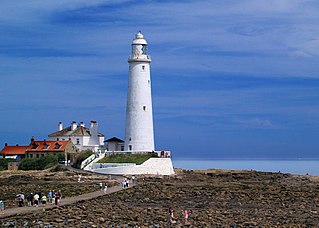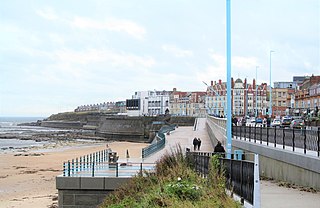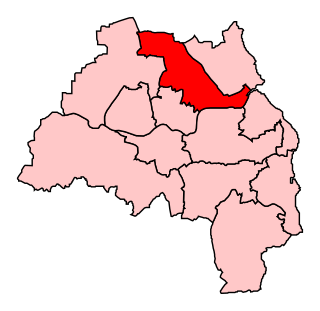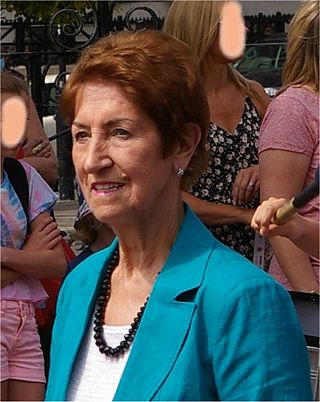
Wallsend is a town in North Tyneside, Tyne and Wear, England, at the eastern end of Hadrian's Wall. It has a population of 43,842 and lies 4 miles east of Newcastle upon Tyne.

North Tyneside is a metropolitan borough in the metropolitan county of Tyne and Wear, England. It forms part of the greater Tyneside conurbation. North Tyneside Council is headquartered at Cobalt Park, Wallsend.

Whitley Bay is a seaside town in the North Tyneside borough in Tyne and Wear, England. It formerly governed as part of Northumberland and has been part of Tyne and Wear since 1974. It is part of the wider Tyneside built-up area, being around 10 miles (16 km) east of Newcastle upon Tyne. Two notable landmarks are the Spanish City and St. Mary's Lighthouse, the latter on a small island near the town.

Tynemouth is a coastal town in the metropolitan borough of North Tyneside, in Tyne and Wear, England. It is located on the north side of the mouth of the River Tyne, hence its name. It is 8 mi (13 km) east-northeast of Newcastle upon Tyne. The medieval Tynemouth Priory and Castle stand on a headland overlooking both the mouth of the river and the North Sea, with the town centre lying immediately west of the headland.

North Shields is a town in the Borough of North Tyneside in Tyne and Wear, England. It is 8 miles (13 km) north-east of Newcastle upon Tyne and borders nearby Wallsend and Tynemouth.

North Shields Fish Quay is a fishing port located close to the mouth of the River Tyne, in North Shields, Tyne and Wear, North East England, 8 miles (13 km) east of the city of Newcastle upon Tyne.
Monkseaton is an area of Whitley Bay, North Tyneside, in the North East of England. Historically in Northumberland, it is in the north-east of the borough, 3⁄4 mile from the North Sea coast and 1+1⁄2 mi (2.5 km) north of the River Tyne at North Shields. One mile to the north of Monkseaton, the extensive built-up areas of North Tyneside change abruptly into green belt stretching north into south-east Northumberland. It is at an elevation of 130 feet (40 m) above sea-level.
Linda Arkley was a British Conservative politician who served as the elected mayor of North Tyneside from 2003 to 2005 and from 2009 to 2013.

North Tyneside is a constituency represented in the House of Commons of the UK Parliament since 2010 by Mary Glindon of the Labour Party.

Meadow Well is a Tyne and Wear Metro station, serving the suburbs of Chirton and Meadow Well, North Tyneside in Tyne and Wear, England. It joined the network as Smith's Park on 14 November 1982, following the opening of the fourth phase of the network, between Tynemouth and St James via Wallsend.

Shiremoor is a village in Tyne and Wear, Northern England. It is in the Metropolitan Borough of North Tyneside and formerly governed under Northumberland. In the 2011 census, it was included in the Tynemouth area of Tyneside. It is near the North East Green Belt, which surrounds Tyneside, Wearside and Durham. It is located around 3+1⁄2 miles from Whitley Bay.

John Harrison is a British Labour Party politician. He was the directly-elected Mayor of North Tyneside in England between 2005 and 2009 and is currently a Councillor on North Tyneside Council.

Dame Norma Redfearn is a British Labour Party politician serving as Mayor of North Tyneside since 2013.
Preston is a suburb about a mile north of North Shields, North Tyneside. Its population was recorded at 8419 in the 2011 census. Historically a separate entity, it has slowly been absorbed into the town to the south and expanded as to form a continuous urban area north to Monkseaton.

Willington Quay is an area in the borough of North Tyneside in Tyne and Wear in northern England. It is on the north bank of the River Tyne, facing Jarrow, and between Wallsend and North Shields. It is served by the Howdon Metro station in Howdon. The area from 2006 onwards has been an area of new housing built on brownfield sites. The house building continues into 2013 and is changing the social and economic balance in the area. The area has also had a make over of the bowling green off Howdon Lane and further warehousing next to the bowling green has been demolished to make way for further new housing. The changes made recently at Willington Quay are now making it an attractive place to live within North Tyneside.
The Riverside Branch was a 6+1⁄2-mile (10.5 km) double-track branch line, which ran between Riverside Junction in Heaton and Percy Main West Junction in Percy Main.
Percy Main is a small village absorbed into North Shields, North East England. Historically in Northumberland, it is now part of Tyne and Wear.
Willington Quay was a railway station on the Riverside Branch, which ran between Byker and Willington Quay. The station served Willington Quay in North Tyneside.
Meadow Well, also known as Meadowell or the Ridges, is a district of North Shields, North East England. Historically in Northumberland, it is now part of the Tyne and Wear Metropolitan county. The population in 2016 was approximately 11,000.













